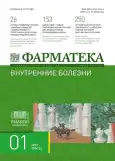Parental compliance level as a key factor in the management of atopy march
- Authors: Gladkov S.F.1,2, Perevoshchikova N.K.2, Levanova L.A.2
-
Affiliations:
- “Clinic of Allergology and Immunology” of the Kemerovo Region
- Kemerovo State Medical University
- Issue: Vol 32, No 1 (2025)
- Pages: 214-220
- Section: Dermatology/allergology
- Published: 20.05.2025
- URL: https://journals.eco-vector.com/2073-4034/article/view/679994
- DOI: https://doi.org/10.18565/pharmateca.2025.1.214-220
- ID: 679994
Cite item
Abstract
Background. Atopic dermatitis (AD) is one of the most common reasons for seeking primary health care for children. Being an immune-mediated dermatosis with a complex mechanism of genetic and environmental interaction, it currently has only a palliative nature of therapy.
Objective. Determination of the degree of influence of the compliance level in patients with atopy on the possibility of managing AM.
Methods. The retrospective cohort longitudinal study included 50 children (main group), who visited the clinic of allergology and immunology in the period from 2012 to 2014 with typical complaints of intestinal dysfunction, manifested by severe intestinal colic (IC), the appearance of pathological inclusions in the stool in the form of mucus, green mucus, in some cases - blood, a decrease in the frequency of bowel movements. The control group included 50 children who visited the clinic of allergology and immunology in the same period with absolutely identical baseline data and complaints. All patients underwent Stool Culture with Bacteria Identification and Antibiotic + Bacteriophage Susceptibility Testing to identify associations of Staphylococcus aureus and Klebsiella pneumoniae, oxytoca, followed by phage decontamination and monitoring the course of AM in dynamics.
Results. The study revealed the presence of excessive growth of Staphylococcus aureus and Klebsiella pneumoniae, oxytoca associations in all children in the study groups. The lg CFU/g levels in the main group were: Staphylococcus aureus – 5.82±1.00 lg CFU/g, Klebsiella pneumoniae – 3.98±0.91 lg CFU/g and Klebsiella oxytoca – 4.46±0.93 lg CFU/g. In the control group: Staphylococcus aureus – 5.78±0.95 lg CFU/g, Klebsiella pneumoniae – 4.12±0.93 lg CFU/g and Klebsiella oxytoca – 4.14±0.92 lg CFU/g. Efficiency monitoring carried out after the end of phage therapy (PT) revealed a significant decrease in the indicators. In the main group: Staphylococcus aureus – up to 2.20±1.19 lg CFU/g, Klebsiella pneumoniae – 1.99±1.19 lg CFU/g, Klebsiella oxytoca – 2.08±1.13 lg CFU/g; in the control group: Staphylococcus aureus – 2.18±1.17 lg CFU/g, Klebsiella pneumoniae – 2.14±1.06 lg CFU/g and Klebsiella oxytoca – 2.22±1.03 lg CFU/g. Initial data of total IgE level at the first control point at 1.6 years: in the main group - 23.92±8.46 IU/ml and 25.72±7.91 IU/ml in the control group. The decrease in the compliance level significantly affected the total IgE level at the second control point of 7 years: 60.28±28.61 IU/ml in the main group versus 103.74±70.19 IU/ml in the control group.
Conclusion. In children with a hereditary predisposition to atopy (based on clinical atopy biomarkers), preventive PT is the main therapeutic component capable of preventing the development of AD trigger reactions. The level of compliance is a determining condition for maintaining the clinical effect obtained from PT.
Full Text
About the authors
Sergey F. Gladkov
“Clinic of Allergology and Immunology” of the Kemerovo Region; Kemerovo State Medical University
Author for correspondence.
Email: doctor.gladkov@gmail.com
ORCID iD: 0000-0002-9088-7914
Allergist-Immunologist, Teaching Assistant at the Department of Outpatient Pediatrics, Propaedeutics of Childhood Diseases and Postgraduate Education
Russian Federation, Kemerovo; KemerovoNina K. Perevoshchikova
Kemerovo State Medical University
Email: nkp42@mail.ru
ORCID iD: 0000-0002-4571-7932
Dr. Sci. (Med.), Professor, Head of the Department of Polyclinic Pediatrics, Propaedeutics of Pediatric Diseases and Postgraduate Training
Russian Federation, KemerovoLyudmila A. Levanova
Kemerovo State Medical University
Email: miss-levanova@yandex.ru
ORCID iD: 0000-0002-5977-9149
Dr. Sci. (Med.), Associate Professor, Department of Microbiology and Virology
Russian Federation, KemerovoReferences
- Крысанов И.С., Крысанова В.С., Карпов О.И., Ермакова В.Ю. Экономическое бремя тяжелого атопического дерматита в Российской Федерации. Качественная клиническая практика. 2019;4:4–14. doi: 10.1016/2588-05192019-4-4-14. [Krysanov I.S., Krysanova V.S., Karpov O.I., Ermakova V.Y. Economic burden of severe atopic dermatitis in the Russian Federation. Qualitative Clinical Practice. 2019;4:4–14. doi: 10.1016/2588-05192019-4-4-14. (In Russ.)].
- Eichenfield L.F., Stripling S., Fung S. et al. Recent Developments and Advances in Atopic Dermatitis: A Focus on Epidemiology, Pathophysiology, and Treatment in the Pediatric Setting. Pediatr Drugs. 2022;24:293–305. doi: 10.1007/s40272-022-00499-x.
- Wollenberg A., Kinberger M., Arents B. Quan, et al. European guideline (EuroGuiDerm) on atopic eczema: part I – systemic therapy. J Eur Acad Dermatol Venereol. 2022;36(9):1409–1431. doi: 10.1111/jdv.18345.
- Kellogg C., Smogorzewski J. Update on Atopic Dermatitis. Adv Pediatr. 2023;70(1):157–170. doi: 10.1016/j.yapd.2023.03.006.
- Атопический дерматит у детей: обновление 2019 (на правах руководства). Согласительный документ Ассоциации детских аллергологов и иммунологов России. М.: ООО «Полиграфическое объединение «Стандарт», 2019. 222 с. [Atopic dermatitis of children: update 2019 (as a guide). Concordance document of the Association of pediatric allergologists and immunologists of Russia. Moscow: LLC “Polygraphic Association ‘Standard’, 2019. 222 p. (In Russ.)].
- Lugovic-Mihic L., Mestrovic-Stefekov J., Potocnjak I., et al. Atopic Dermatitis: Disease Features, Therapeutic Options, and a Multidisciplinary Approach. Life. 2023;13:1419. doi: 10.3390/life13061419.
- Перевощикова Н.К., Гладков С.Ф., Пичугина Ю.С. и др. Ранняя постнатальная коррекция микробиоты кишечника как главный фактор первичной профилактики атопии. Мать и Дитя в Кузбассе. 2021;1(84):108–127. [Perevoshchikova N.K., Gladkov S.F., Pichugina Y.S., Surkova M.A., et al. Early postnatal correction of intestinal microbiota as the main factor in the primary prevention of atopy. Mother and Child in Kuzbass. 2021;1(84):108–127.
- Патент № 2828551 Российская Федерация, № 2024104396. Способ прогнозирования риска развития атопического дерматита у детей в первые четыре недели жизни. Гладков С.Ф.: заявлено 21.02.2024: опубликовано 14.10.2024. [Patent No. 2828551 Russian Federation, No. 2024104396. Method of predicting the risk of atopic dermatitis development in children in the first four weeks of life. Gladkov S.F.: stated 21.02.2024: published 14.10.2024. (In Russ.)].
- Гладков С.Ф., Перевощикова Н.К., Черных Н.С. Эффект фаготерапии у пациента с атопическим дерматитом: клинический случай. Мать и Дитя в Кузбассе. 2024;4(99):94–98. doi: 10.24412/2686-7338-2024-4-94-98. [Gladkov S.F., Perevoshchikova N.K., Chernykh N.S. Effect of phagotherapy in a patient with atopic dermatitis: a clinical case. Mother and Child in Kuzbass. 2024;4(99):94–98. doi: 10.24412/2686-7338-2024-4-94-98. (In Russ.)].
Supplementary files








